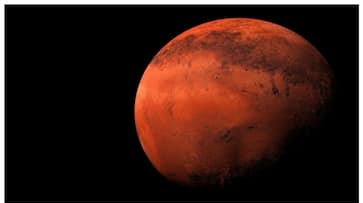Recent findings reveal Mars contains enough water to fill a deep ocean, hidden beneath its surface. This discovery provides new insights into the planet's history.
Scientists have made a groundbreaking discovery about Mars, revealing that the planet holds enough water to fill an ocean a mile deep. This significant finding comes from recent research published in the Proceedings of the National Academy of Sciences, based on seismic data collected by NASA’s robotic InSight lander. The study, conducted by researchers from the University of California, Berkeley, and UC San Diego, uncovers a hidden reservoir of water deep beneath Mars' surface.
Seismic Data Reveals Water Deep Below
NASA’s InSight lander, which spent four years studying Mars' seismic activity, has provided crucial insights into the planet’s interior. The lander’s seismometer recorded numerous tremors, or quakes, from deep below the surface. By analyzing these seismic signals, scientists discovered evidence of liquid water located between 11.5 and 20 kilometers beneath Mars’ surface. This water, while inaccessible to humans, could have significant implications for the potential existence of microbiological life on Mars, either in the present or in the past.
Dr. Vashan Wright from Scripps Institution of Oceanography at UC San Diego, co-author of the study, noted that the volume of water detected is greater than previously estimated volumes thought to have filled ancient Martian oceans. According to Wright, the findings suggest that the water is trapped in rock fissures within the Martian mid-crust. If the data from InSight is representative of the entire planet, this could equate to an ocean 1-2 kilometers deep.
Implications for Martian History and Future Research
The discovery sheds light on Mars’ ancient climate and geological history. Scientists believe that the Martian water cycle once involved infiltration of water into the crust, a process that likely occurred when Mars was warmer and wetter. This water would have contributed to the planet’s earlier, more hospitable conditions before the surface became cold and barren over three billion years ago.
Insight's mission, which concluded in December 2022, recorded over 1,319 earthquakes, aiding scientists in their calculations. These techniques, similar to those used for water and oil exploration on Earth, have provided a new understanding of Mars’ hidden water resources and its historical climate dynamics.
Last Updated Aug 13, 2024, 3:57 PM IST









![Salman Khan sets stage on fire for Anant Ambani, Radhika Merchant pre-wedding festivities [WATCH] ATG](https://static-gi.asianetnews.com/images/01hr1hh8y86gvb4kbqgnyhc0w0/whatsapp-image-2024-03-03-at-12-24-37-pm_100x60xt.jpg)
![Pregnant Deepika Padukone dances with Ranveer Singh at Anant Ambani, Radhika Merchant pre-wedding bash [WATCH] ATG](https://static-gi.asianetnews.com/images/01hr1ffyd3nzqzgm6ba0k87vr8/whatsapp-image-2024-03-03-at-11-45-35-am_100x60xt.jpg)


